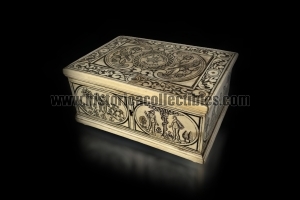Personal Casket belonging to Bishop Leone Strozzi, circa 1680
Rectangular-shaped casket, with flattened ball feet and hinged lid, which belonged to (Giambattista) Leone Strozzi when he still held the ecclesiastical office of Bishop of Prato and Pistoia, in the period between 1680 and 1700. Subsequently, 1700, until upon his death in 1703, he held the ecclesiastical office of Metropolitan Archbishop of Florence.
The casket is completely covered in bone and engraved on all sides with the stories of creation (Old Testament) and the Passion of Christ (New Testament). The representations are formed by the creation of Eve, the reference to the tree of knowledge, sin, the expulsion of Adam and Eve from Paradise and the crucifixion of Christ. Shown in a circle, placed in the center of the lid, there is the emblem of the Strozzi family of Florence to which Leone belonged, with the writing "Leone Strozza Episcopus" and the three half-moons symbol of the Strozzi family of Florence. Finally, inside its lid, there is the painted inscription "Leone Strozza Episcopus - Pistoriensis et Pratensis" Ordinis Benedicti Vallis Umbrosæ - A.D. MDCXC, confirming his religious belonging to the Vallombrosian Benedictine Order of which he was Abbot of San Salvatore in Vaiano and Santa Trinita in Florence, as well as Procurator of his Order for Tuscany in 1672.
The measurements are: Length 21 cm; Height 10.5 cm; Depth 15 cm.
References:
Museum Huelsmann, Precious and mysterious, Cat. n° 19.
Schloss Ahlden Auktion 185 - Teil III - Item 3051 Page 1052
Biography:
Leone Strozzi, OSB (1638–1703) was a Roman Catholic prelate who served as archbishop of Florence (1700–1703) and bishop of Pistoia and Prato (1690–1700). Leone Strozzi was born in Florence, Italy, in 1638 and was ordained a priest in the Order of Saint Benedict. On 10 July 1690, he was appointed during the pontificate of Pope Alexander VIII as Bishop of Pistoia and Prato (Tuscany - Italy). On 6 August 1690 Paluzzo was consecrated bishop by Paluzzi Altieri Degli Albertoni, cardinal-bishop of Sabina, with Prospero Bottini, titular archbishop of Myra, and Nicolò d'Arcano, bishop of Comacchio, serving as co-consecrators. On June 21, 1700, he was appointed during the pontificate of List of Popes as archbishop of Florence. He served as Archbishop of Florence until his death on 4 October 1703. References Titles of the Catholic Church Bishop of Pistoia and Prato 1690–1700 Archbishop of Florence 1700–1703.

